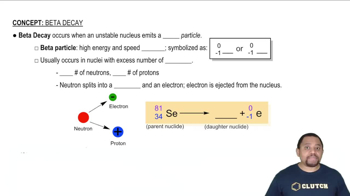Here are the essential concepts you must grasp in order to answer the question correctly.
Radioactive Decay
Radioactive decay is the process by which an unstable atomic nucleus loses energy by emitting radiation. This process occurs at a predictable rate for each radioactive isotope, characterized by its half-life, which is the time required for half of the radioactive atoms in a sample to decay.
Recommended video:
Rate of Radioactive Decay
Half-Life
Half-life is a specific measure of the time it takes for half of a given quantity of a radioactive substance to decay. It is a constant for each isotope and is crucial for calculating the remaining quantity of the substance over time, as well as for understanding the decay process in nuclear chemistry.
Recommended video:
Exponential Decay Formula
The exponential decay formula describes how the quantity of a radioactive substance decreases over time. It is expressed as N(t) = N0 * (1/2)^(t/T), where N(t) is the remaining quantity at time t, N0 is the initial quantity, and T is the half-life. This formula allows for the calculation of remaining mass after a certain period, which is essential for solving decay problems.
Recommended video:





